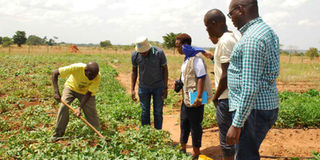Sustainability makes irrigation good business

A farmer weeds his sweet potato garden in Nakasongola. His garden is maintained by drip irrigation. PHOTO BY LOMINDA AFEDRARU
What you need to know:
As Uganda continues to undergo uncertain and inconsistent weather patterns manifesting in prolonged dry spells and erratic rainfall lasting shorter periods, adoption of irrigation technology is increasingly getting attention as a solution to such challenges, writes Lominda Afedraru
Since many of farmers in the country are practicing farming on small scale, it is essential to make irrigation technologies more accessible to them in order to increase their income through increased yields.
Experts say the country needs urgent investment in irrigation to increase resilience in the agricultural sector. The country’s irrigation policy sets a target of total irrigated area of 1,500,000ha by 2040 compared to the current 77,000ha.
To achieve this, a range of locally-adapted irrigation models are needed and this must be farmer-led to be successful.
As such, development partners, in particular Alliance for Green Revolution, in conjunction with the Ministry of Agriculture have come on board to help drive this initiative.
The commissioner for Infrastructure, Mechanisation and Water at the Agriculture ministry, Ronald Kato Kayizzi noted that this is a tool to increase agricultural production for the growing agro industry sector in the country.
“The ministry is encouraging farmers to get involved in farmer-led irrigation. We are looking at acquiring irrigation equipment, which can be offered to farmer groups at subsidised costs and we are going to sensitise the farmers by involving the extension service workers across the country.
This will help in production throughout the year even during the dry spell,” he said.
To him, there are abundant water resources in the country, including rainwater harvesting in underground water tanks, valley tanks, valley dams and natural water bodies.
In the ministry irrigation policy, farmers to be considered are those who can practice macro irrigation on five-acre land, macro irrigation on 100-150ha, medium irrigation on 100- 1,000 ha and large scale irrigation on 1,000 ha and above.
The ministry, according to Kayizzi, is working with Alliance for a Green Revolution in Africa (Agra) and the World Bank. Apparently, it is drafting a proposal requiring about $200m for implementation of farmer-led irrigation farming across the country.
Dr John Jjagwe, Agra country manager, noted that it is important for farmers who are considering to engage in adopting irrigation technology to engage in commercial farming which is done on relatively large scale because the technology is expensive to operate.
He recommends farmers to carry out irrigation with good agronomy practices in order to realise the required yield.
These include good seeding practices, proper land tillage, right time of planting, weeding and when to irrigate. Application of pesticides for pest and disease management.
What to consider
Kayizzi explains that for farmers to adopt the technology, they must consider the type of crop under irrigation. The ministry is emphasising horticulture crops, which include vegetables and fruit, herbal and spice plants and coffee.
These are high value crops out of which farmers are capable of fetching better income resources even during dry spells. Other factors to consider are water resource and the volume of water required, soil texture and type of irrigation to adopt.
Benefits
Kayizzi notes that the various technologies can help small farmers improve their livelihoods by allowing for a more efficient use of inputs, such as water and fertiliser and by enhancing the yields and quality of the crops.
This will involve efficient water use for more productively, larger farm areas by using the same amount of water for a relatively less area coverage. This helps in improving crop yields and quality through direct impacts, as well as indirect ones, such as decreased soil salinity, fewer attacks from pests and diseases and less weed competition.
In the presence of functioning markets and a favourable business environment, these changes in turn help generate higher incomes and better livelihoods for farmers.
This helps farmers in vulnerable regions to adapt and strengthen their resilience to climate change.
Efficient irrigation reduces the amount of fertiliser needed per plant as nutrients can be dissolved in the irrigation water for uniform application, reduced waste and lower labour input
It also reduces energy use because less water is needed for a comparable area of irrigation, which in turn requires less energy for pumping this water. When automated, farmers are also easily and safely irrigate crops during times of fewer power disruptions.
Types of irrigation
When water supplies are adequate, irrigation can increase crop yield dramatically. Different irrigation systems are suited to different soils, climates, crops and resources. Below are the common types of irrigation farmers can adopt.
Drip irrigation is efficient for smallholder farmers, only that it is very expensive to install.
Sprinkler irrigation, which is in the form of downpour provided by sprinklers, is cost-effective for large chunks of land while centre pivot irrigation moves water on wheeled towers in a circular pattern.
Manual labour using watering cans is labour-intensive as well as surface irrigation distributes water over and across land by gravity without mechanical pumps involved.
Drip irrigation
Drip irrigation, in a nutshell, is the process of lacing your garden area with irrigation lines that feed into the root systems of your plants, “dripping” water into them gradually.
This is a most efficient system because it allows farmers to directly hydrate plants without having to water the surface and because drip systems feed directly into the roots, they are much more efficient in their net water usage. The challenge is that it is expensive to install and requires regular maintenance, which may be costly




